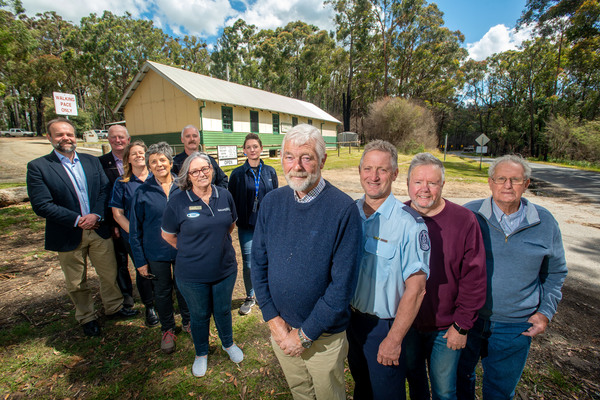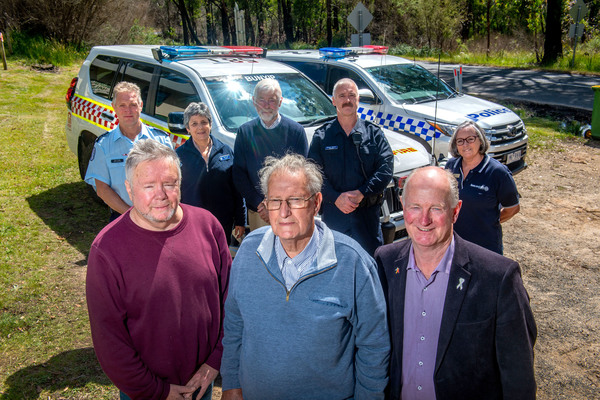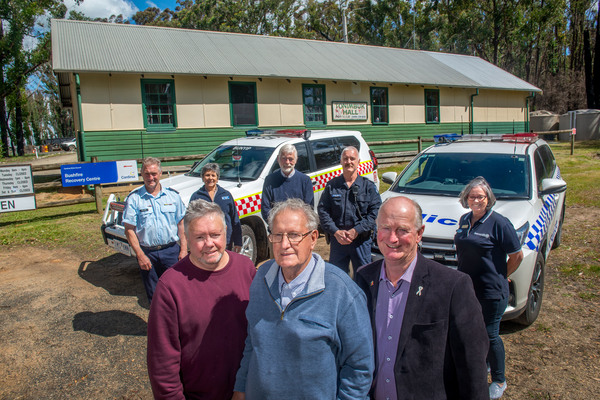
By Jessica Anstice, Mitchell Clarke and Danielle Kutchel
Community organisations played a crucial role in the response and recovery efforts of the Bunyip bushfires.
From the beginning, throughout 2019 and into the new year, those contributions have proved vital to victims, who are still “hurting” almost a year on.
Impossible to name just one person, the 2019 Gazette Person of the Year title instead went to deserving groups who banded together for the sole purpose of providing relief.
Tonimbuk Hall, remarkably, survived the fires which swept through Bunyip State Park and destroyed 29 houses and 67 sheds, leaving hundreds displaced and distraught.
That very hall has provided a second home to bushfire affected victims as well as a base for volunteers and other organisations.
Alan Blackwell, who helped set up the recovery centre, has spent a lot of time reflecting on his role in the recovery.
He was approached due to his experience running similar efforts in the aftermath of Black Saturday and Ash Wednesday.
“I didn’t do as much as I would’ve liked to, because of my age. I was approached by some volunteer groups that worked with us at Labertouche. Straight away, we got into it,“ Mr Blackwell recalls.
“Having been through it a few times before, I had a good idea what needed doing.
“It was pretty hectic. We didn’t have enough people to run it, so I’m glad that the council were available to step in. I just did what I thought needed doing.”
Cardinia Shire Council’s former mayor Graeme Moore and colleagues were instrumental in their response to the disaster.
“It was a shock for everyone – we were all caught by surprise,” Cr Moore said.
“I did my best to keep the community together but there were probably things that I would change today but there isn’t much because there wasn’t any time to stop and think.
“You had to do what you could at the time and sometimes those things are knee jerk reactions to situations.”
Bunyip Fire Brigade captain John Cooper led 28 strike teams as the fire tore through 16,000 hectares of the Bunyip State Park.
“From what the CFA did, I think we did a really great job,” he said.
“To have a fire of that size and losing 29 houses and no loss of life, it’s a fantastic result.”
Mr Cooper credited residents who had a bushfire plan in place.
“People who were planned did a good job, people that don’t plan ahead are the ones who get into trouble.
“If you’re not planned, get out, don’t be here because that’s when we lose loss of life, when people think they’ll be alright, but it’s often too late.”
On being recognised for the award, Mr Cooper spoke on behalf of all firefighters and said it was “great” to be recognised for their efforts.
“The CFA get recognised for the bushfires, but we’re going at it all year around,” he added.
“The whole brigade in Bunyip and the brigades around us and all those that came to help us, we really are starting to get appreciated by the locals.
“Unfortunately you might be sitting down on Christmas Day and the pager goes off and you go out to it because that’s someone in need.”
Police officer and local man Danny Hower didn’t think twice about helping with the fire recovery.
“It started out with just doorknocking with fellow volunteers, getting a list with people’s details and needs,“ he said of his involvement.
“Then I was assisting with whatever was going on in the recovery centre, more physically than anything else, and I tried to get out and help with their recovery on their properties in a volunteer sense, not as a police person.
“It was just an ‘as-things-were-needed’ response.
“There’s a lot of fulfilment in helping people. Giving is better than taking.”
Another volunteer recognised for their efforts was Lions Club volunteer Shirley Higman.
“It was a lot. It takes over your life,” Shirley explained, describing the recovery efforts.
“From the moment we started it was just non-stop.
“There wasn’t a second to even think about what it was we were doing. We responded to anything and everything.”
Local BlazeAid founders John and Sue Anderson led 600 volunteers to clear 300 kilometres of damaged fence lines and re-fence 150 kilometres.
The group began work immediately, on 12 March and finished up on 16 August.
“It was a massive effort but that is what we did,” John Anderson said.
“The mere fact that the BlazeAid volunteers turned up to somebody’s farm just to have a cup of tea and talk to them made a big difference – particularly after something like that.
“One person said to me ‘we haven’t got anything now but we’ve now got fences and that’s a start’.”
From a BlazeAid volunteer’s perspective, Mr Anderson said the most rewarding part now is driving down Tonimbuk Road and seeing cattle in paddocks.
“It makes it all worthwhile,” he added.
“In March there were no fences and no feed but now you drive around and see cattle grazing and pastures coming back.
“It was a huge team effort.”
Speaking of team efforts, Tony Fitzgerald has led the Community Recovery Committee for the Bunyip Fire Complex as chairman.
“Our role is to advocate for the community and by the end of June there will be nobody from council here as this will be winding up and the committee will be the body that will continue on and continue to support community members – until whatever it takes,” Mr Fitzgerald said.
With the assistance of fellow members including vice chair Sue McMahon, Liz Wishart, Gary Burns, Jane McLaughlin and John Fitzpatrick, the group have provided a voice for those who have felt unheard.
“Unfortunately disasters do have that positive outcome – it can bring the community together,” he added.
“I think the community here is very resilient. The biggest thing about recovery is actually community.
“I’ve got to sincerely thank our committee – they’ve done a great job, particularly the people who lost everything and are now helping other people, and it’s been a big commitment.”
Despite this, Mr Fitzgerald said there is “still a lot of pain out there”.









